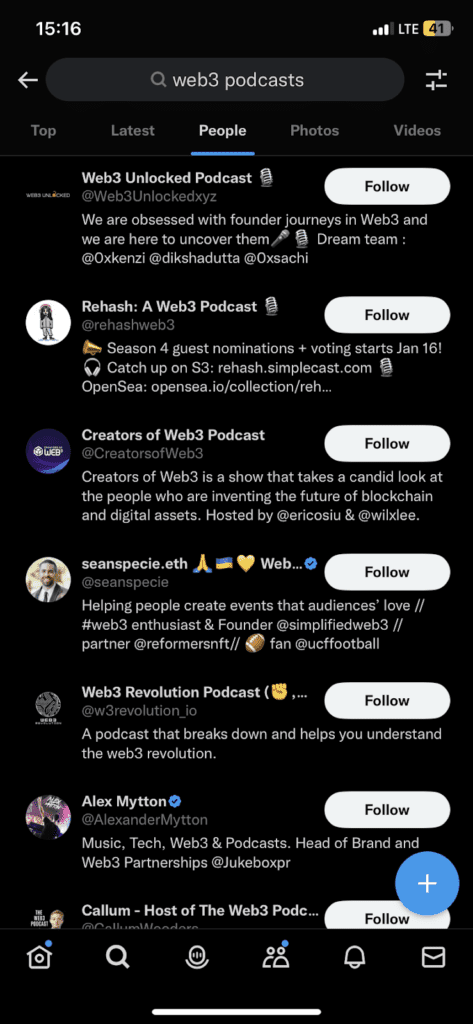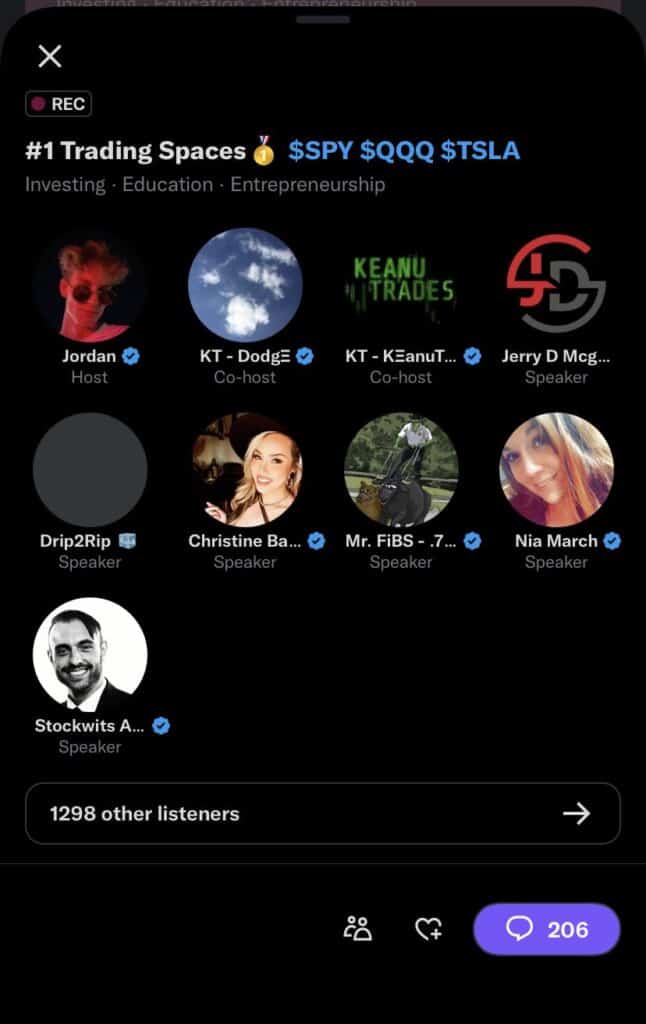If you’re looking to reach a new audience and build a community around your podcast, promoting it on Twitter can be a game changer.
With over 450 million active users, Twitter provides a powerful platform for discovery, engagement and audience growth.
However, with so many other podcasts seeking attention on social media platforms, standing out can be difficult. But with the right strategy, you can easily promote your podcast on the platform and grow your podcast audience.
In this guide, you’ll find six proven tips on how to promote your podcast on Twitter.
1. Tweet about New Episodes
You don’t have to have a lot of technical knowledge to know how to promote a podcast on Twitter. Start by tweeting about new podcast events. These tweets can come before or right after you release the new episode.
However, simply sharing a link to the podcast or tweeting “episode 3 of our podcast tomorrow” won’t cut it. You must come up with interesting and interesting tweets that will attract your audience to click and listen.
One way to achieve this is by considering what your audience can expect from the new event. An example of this can be a statement from the event, as shown below, or a string compiled in a contribution that provides an overview of the topic.
You can also create a teaser to boost your competitive advantage. According to Twitter Business, tweets with video record 10x more engagement than tweets without. The more likes and retweets you get, the better your chances of getting into the Twitter feed of potential listeners. So, if you make a video podcast, you can release an interesting part as a teaser. But be careful not to overdo it.
However, if your podcast content is mostly audio, you can create an audiogram as Headgum did below. Audiogram podcasts are a form of music streaming. You can create your own using Castos Headliner Integration.
You can also post your video teaser and audiogram on your podcast website. Just make sure you have the best web hosting service so that your audience doesn’t have a hard time calling them.
Also, include a call to action (CTA) in your tweets. You can tell your listeners to “subscribe for new episodes” like Headgum did above or to “listen now” or “skip to new episodes.” A CTA can encourage your followers to take action and start listening to your podcast.
Finally, scheduling your tweets can also be an effective way to promote your podcast. With a well-planned strategy, you can reach more of your audience at the right time. However, before scheduling, understand when your audience is most active. Below are tips:
Use an app like Buffer or Hootsuite to organize your tweets according to a scheduled time.
Of course, when you tweet for your podcast, you must tweet at the right time, with the right content and the best CTA.
2. Delete Background Content
Learning how to promote your podcast on Twitter requires knowing how to build a connection with your audience and promote a sense of community. One way to achieve this is by giving your listeners a unique look into the behind-the-scenes (BTS) process of making your podcast.
By sharing your BTS, you’re giving them a little insight into the personality behind the mic. This can help you personalize your podcast and develop a strong community.
You can share your behind-the-scenes content in a variety of ways. For one, you can share a video or photo of yourself recording a podcast in the studio. If you have a guest, you can also share their reviews or videos.
Here is an example from the MStranslate podcast.
And, you can make your BTS video look professional using different effects. There are often free templates available out there.
Twitter’s live streaming feature is another option to explore. Use this feature to share live recording sessions, giving an inside look into the creative process of your podcast.
Your content behind the scenes doesn’t always have to be your own videos or images. You can also share a visual representation of the program, including headlines, guest bios, etc. These pieces of content give your audience a sense of what they can expect from the event, thus making them want to click the “play” button.
3. Add a Twitter poll
You can use Twitter polls to ask questions about what your audience expects from your upcoming podcast episode. For example, if you’ve published teasers about a special guest in your email campaign the next day, you can create a poll asking your audience what they think your guest will discuss. Or you can ask them who they think your special guest will be at your upcoming event.
You can promote your podcast using indirect Twitter polls, too. You can, for example, gather feedback on what your listeners want or don’t want to hear on your next podcast episode. Check out this example from PlanetFpl:
When promoting your podcast, polls can also help you decide:
- Your target audience wants to show it off
- Get ready for the new episode
- Frequency of your event.
Finally, you take your audience to the creative process.
When creating a poll, you want to keep it simple, short, and straightforward. Besides that, add short and clear calls to action like “vote us,” “vote now.” This will encourage your employees to participate in the poll and provide valuable insights.
4. Connect with other podcasters
Reaching out and collaborating with other podcasters is an effective way to expand your reach and get your show to a new audience.
However, you only need to interact with podcasters around your niche. You don’t want to associate podcasting with self-help if your niche is database software.
Now, the question is, how do you find the right podcast for the collection? Start by searching for podcasts in your industry or niche using Twitter’s search function. Enter your “niche” + “podcast” in the search tab. Then, go to the “People” section, as shown below.

You will find many podcasts that are relevant to your industry. You can follow them, engage with their content, and reach out to visitors to start a conversation. Instead of DM, some podcasters prefer to be emailed. To ensure that your email reaches them as intended, check the email regularly address in your contact list before clicking the send button.
It’s not just that. You can use social networking programs and online communities like Reddit boards, where you can also find people you can interact with. Ask for their Twitter handle and start a relationship with them.
There are several ways to connect with other podcasters. For one, you can organize a crossover event, where another podcaster in your niche can appear on your event. Also, you can interact with each other’s activities.
As a building block of this joint event release, you can share content with each other or even support a joint Twitter space. Space is where people come together on Twitter to discuss a topic through live audio chat.
With these, you introduce your show to a new audience and expand your reach. Below is an example of a Web3 Unlocked collaboration with the Push Protocol Podcast:
You can also ask podcasters to retweet or promote your podcast.
When working with other podcasters, have clear expectations and goals. Always communicate with them and be open to feedback.
Overall, organic collaboration with podcasters is always a win-win situation. Both of you will get a lot of opportunities and benefit from the partnership.
5. Connect with your followers
Engaging with your followers is key to building a community around your podcast. So, don’t just tweet and walk away. You want to develop a relationship with your followers.
There are different ways to communicate with them. The three main and easiest methods are;
- Responding to tweets
- Redirecting content from your followers
- Participate in discussions related to your industry.
Another way to interact with your followers is to host a Twitter feed. This is what that looks like.

By hosting a Twitter feed, you can connect with your followers instantly and build a community around your podcast.
Before accepting the Twitter space, you need a topic that fits your podcast. During the space, people can also tweet their thoughts on their Twitter timeline. So, create a hashtag for the space and encourage your audience to use them when you tweet. This ties in well with the next point.
6. Use the right Hashtags
Hashtags are an effective tool to promote your podcast on Twitter. So, whenever you tweet about your podcast, always include popular and relevant hashtags. This is a great way to increase your visibility and get your podcast to a new audience looking for content related to the hashtag topic.
How do you get these hashtags? Start by understanding what your competitors are using. You will find your competitors by following the instructions on the fourth page.
So, if you’re doing a marketing podcast, you can use Podcast Marketing hashtags in your content. The podcast is an authority in a marketing niche.
You can also enter your niche hashtag into the Twitter search tab. You will find a bunch of related hashtags to use for your tweets. This is an example of #marketing.

To make it easier, you can use social listening tools like Hashtagify or RiteTag to find popular hashtags in your niche. These apps will let you know how popular hashtags are, related hashtags, and the best time to use these hashtags.
Additionally, create a unique hashtag for your podcast. Your listeners can use this to discuss the events of your podcast. Make sure the hashtag is your brand name, eg, #thedevspodcast, #Timsmoment, etc. This is another way to create a sense of community around your podcast and promote your brand.
Finally, according to Twitter, the best practice is to use less than two hashtags per tweet. So, don’t clutter your posts with hashtags.
In conclusion
Promoting your podcast on Twitter is an effective way to reach new audiences and build a sense of community around your show.
If you’re wondering how to promote your podcast on Twitter, start by tweeting about your new program. Make sure these tweets have the right hashtags. You also want to interact with your followers and other podcasters. Don’t forget to take advantage of Twitter polls and content in the background.
Combine these features and watch your podcast listening stats evolve.

Guest Post from Matt Diggity, CEO of Diggity Marketing
Matt Diggity is a search engine optimization expert and the founder and CEO of Diggity Marketing, The Search Initiative, Authority Builders, and LeadSpring LLC. He is also the host of the Chiang Mai SEO Conference.
Podcasting just got a lot easier
With Castos, you’re just a few clicks away from launching an impactful podcast for your brand.


0 Comments